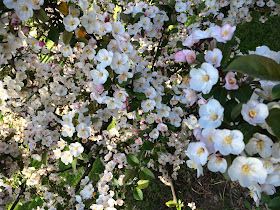There's a great website called
The Kitchn. I think it's a foodie off-shoot of another great site called Apartment Therapy - which I've visited often. I discovered the site because a friend of mine kept posting recipes from the site that REALLY appealed to me. I found myself "sharing" a lot of these recipes, just so I could find them again. (I couldn't just go to the site and start following it, like a normal person...)
The first time I ever had almond milk was, as a very young person, during a visit to Sicily to see my family. My cousin (actually my grandmother's first cousin), Nino, took me for a passagiare, which is the practice of taking a post-dinner walk around town. As is common, we walked to the town square to have a treat and he recommended the having the almond milk. I thought I'd died and gone to heaven.
Almonds figure heavily in Sicilian cuisine so I already had a familiarity and love for the taste but this was something else entirely - intense, smooth, slightly sweet. It was amazing. Unfortunately, commercial almond milk that's available here is too sweet and not at all like the drink I still have on those rare occasions that I get to visit Sicily.
So... off to try this, seemingly simple, recipe in my own kitch(e)n!
Step one: Soak raw, preferably organic almonds in water overnight or up to two days.
This step was easy - although I didn't read the instructions properly and I put them in a covered mason jar instead of an uncovered bowl. I'm not sure if this made a difference but the idea of leaving an uncovered bowl of soaking almonds on my counter seemed...um...disgusting and bug-attracting.
 |
| Although, after two days, this is pretty gross too |
Step two: Drain and rinse the almonds
Step three: Put almonds and clean water in a blender
Again, easy enough. Although, don't fill the blender too full or it will spill over. I ended up doing my blending in two batches.
Step four: Pulse until almonds are chopped up, then blend for a full two minutes
So, seriously, two minutes is a LOT longer than you'd think. I actually set a timer and was surprised at how long this seemed. I'd highly recommend timing it instead of going on instinct or, I promise, you won't have blended it enough.
Step five: Strain the blended almonds
 |
| My first (failed) attempt |
So...yeah. Here's where things got sticky (and messy). My first attempt was to use cheesecloth. That got me nowhere fast. The stuff just sort of sat on top of the cheesecloth not draining and, again, I wasn't about to leave it on the counter and just walk away for a couple of hours while it dripped - glacially slow. So, I strained in two steps:
- I strained the milk through a fine-mesh sieve, pushing against the solids with the back of a wooden spoon, squeezing out as much milk as possible.
- I filtered the milk a second time through coffee filters. The finer silt that was left was minimal but it made a difference in the "grittiness" of the milk. And I wanted the very smooth milk that I remember.
 |
| Part two of straining |
The final product is smooth and very tasty. I chose not to sweeten it but, if I did, I would use a small amount of honey. The last tip I have is this: the actual recipe (link above) calls for 1 cup of almonds to 2 cups of water, with 2 cups of clean water to blend with in step four. I found my final product to be more watery than I would like and I think, in the future, I'll blend with 1/2 the water called for, in order to try to give the milk a little more "body".
 |
| Yummy on cereal! |

Overall, it wasn't a bad first try although I would like to find a more efficient straining system.
Finally, what to do with the left over ground almonds? The recipe suggests using them "as is" as an additive in smoothies or yogurt (good addition of protein) or drying it to make almond meal which can be used in baking. I decided to try drying it out just to see what the process was like. The answer... long and arduous. LOL In a 200 degree oven, spread out on a cookie sheet, the meal took nearly four hours to dry to a point where it felt like almond meal. I had to go in occasionally and break up the lumps so they'd dry too. I now have a bag of almond meal in my freezer that I'll have to find a use for at some point. Maybe a coating for fish??


Oh! And the almond milk only lasts a few days to a week in the 'fridge so don't make a lot unless you're really thirsty. It will separate but that's not "going bad" - you just have to shake it. You'll know if it's bad because it will start to taste sour. A little honey could help extend the life because it wards off bacteria, for what that's worth.
Give it a try, if you like almond milk or think you might like almond milk. Then, on a warm summer evening, sit on the patio and sip a glass. You may feel like you're in Sicily for a few minutes. :)
- Alex




















































